Dans le supplément Art de La Libre ce mercredi
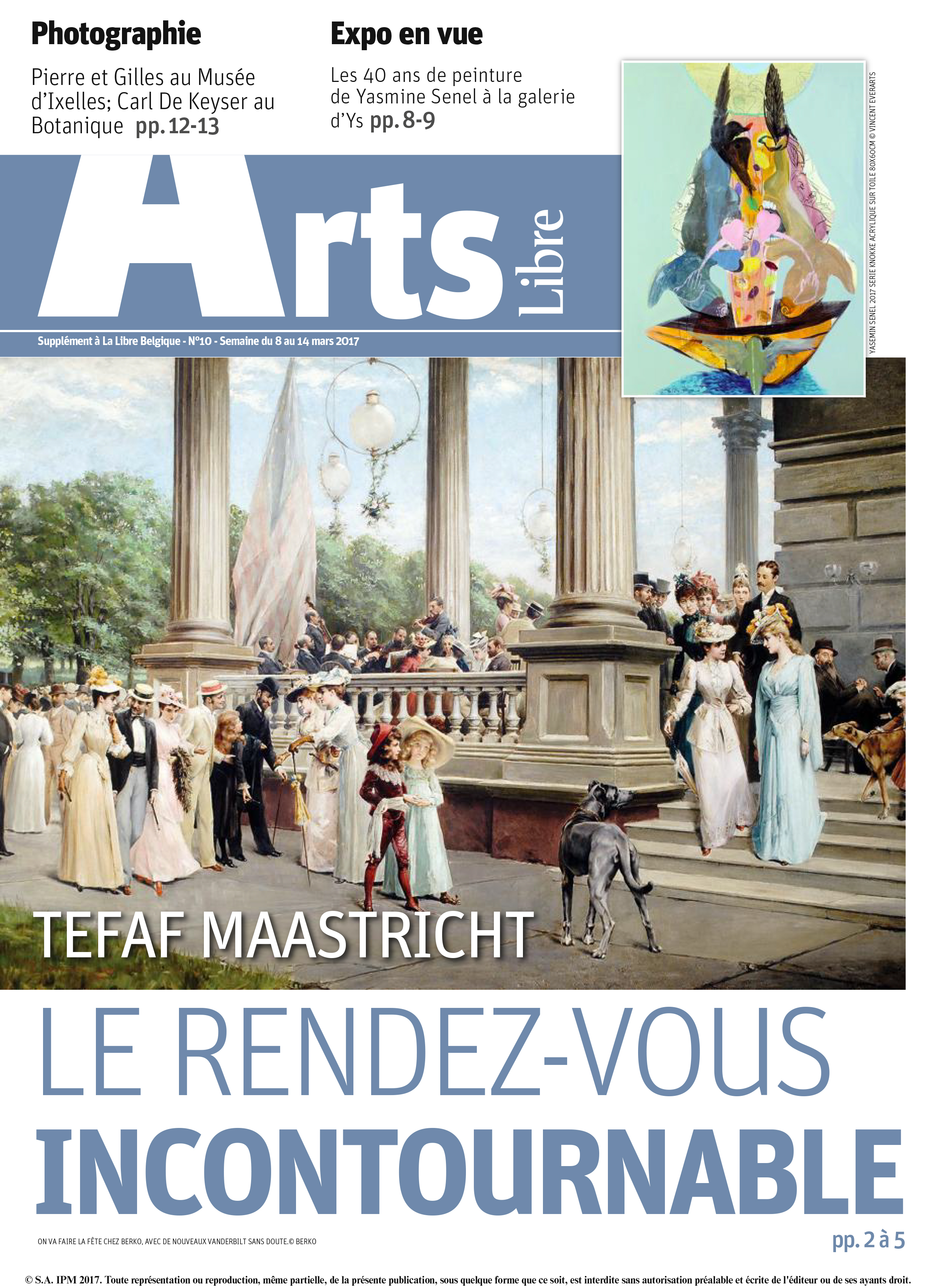
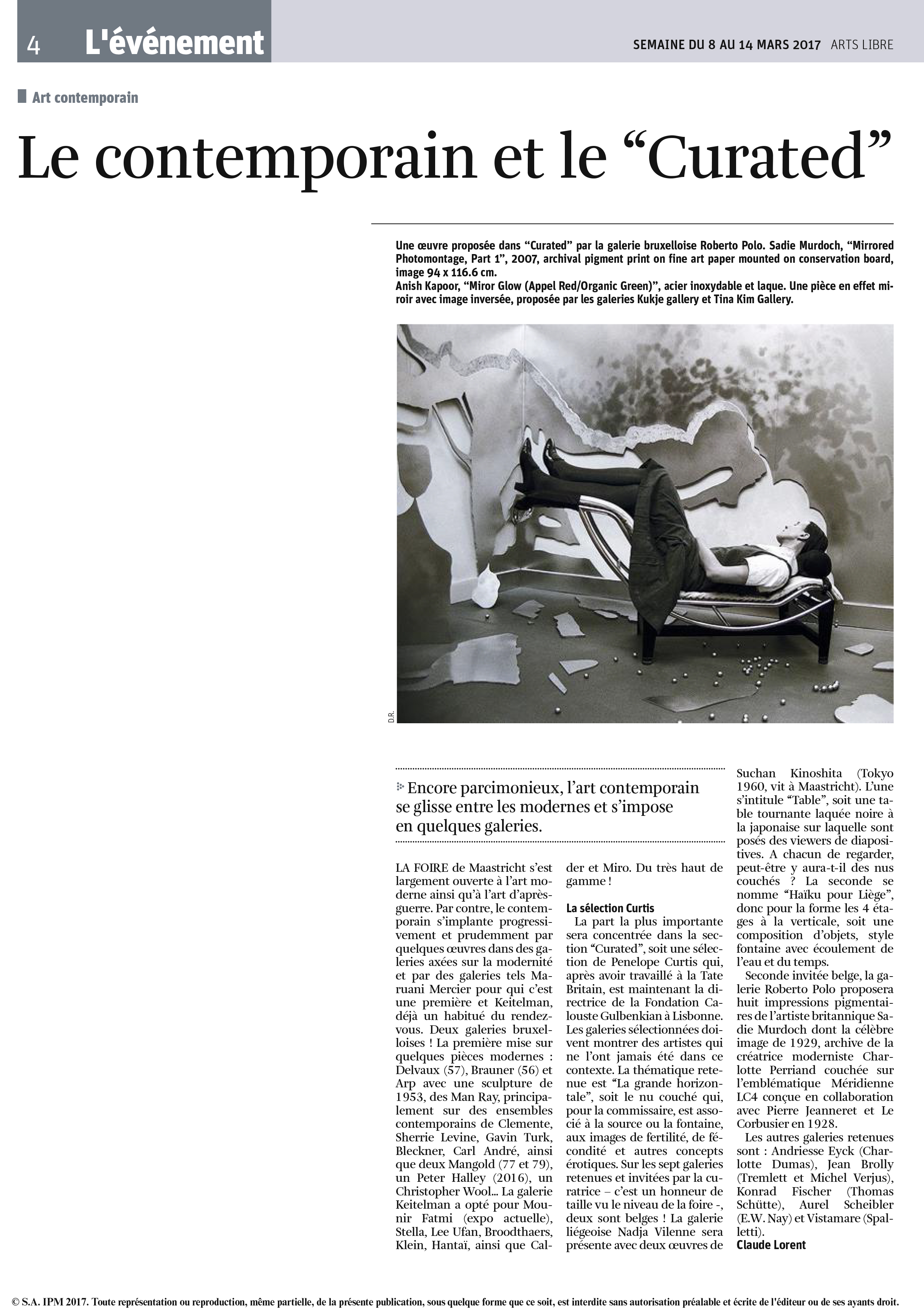
[sociallinkz]
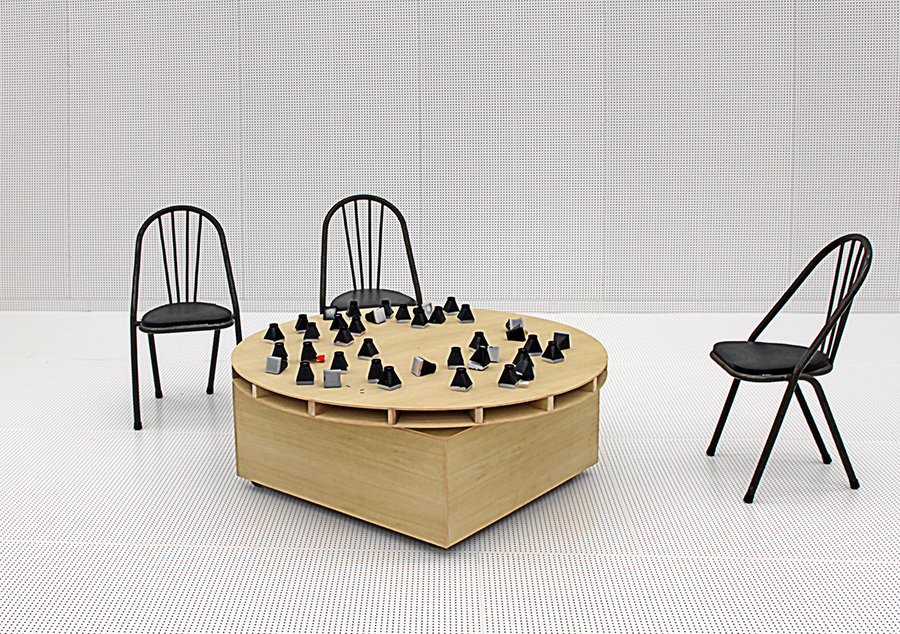
During TEFAF / Tijdens TEFAF / Durant la TEFAF
RESONANCES
James Lee Byars
Jacques Charlier
Lili Dujourie
Sophie Langohr
Jacques Lizène
Emilio Lopez-Menchero
Jacqueline Mesmaeker
Guy Mees
Benjamin Monti
John Murphy
Pol Pierart
Maurice Pirenne
Valérie Sonnier
Raphaël Van Lerberghe
Marie Zolamian
10 March – 19 March 2017, only by appointment @ 0032475905226 /
Du 10 au 19 mars 2017, seulement sur rendez-vous @ 0032475905226
Public opening Saturday 18 March 2017 at 7 PM / Vernissage le samedi 18 mars à 19h
26 March – 15 April 2017, Thursday to Saturday 2–6 PM or by appointment /
Du 24 mars au 15 avril 2017, Jeudi – Samedi de 14 à 18h
[sociallinkz]
![]()
La galerie Nadja Vilenne a le plaisir de vous annoncer sa participation à la TEFAF Curated – Maastricht.
Nadja Vilenne Gallery is pleased to announce its participation in the TEFAF Curated – Maastricht.
La galerie montrera des oeuvres de / the gallery exhibits works by :
SUCHAN KINOSHITA
TEFAF CURATED 2017
LA GRANDE HORIZONTALE
THE THIRD EDITION OF TEFAF CURATED WILL BE CURATED BY PENELOPE CURTIS, DIRECTOR OF THE CALOUSTE GULBENKIAN MUSEUM, LISBON. THE SECTION WILL HOST A SELECTED GROUP OF GALLERIES EACH EXHIBITING WORKS BY CONTEMPORARY ARTISTS ON THE THEME OF THE RECLINING OR RECUMBENT FIGURE.TEFAF Curated aims to show works by artists that have previously not shown at the fair and is designed to complement the fair’s modern and contemporary section.
La Grande Horizontale
The recumbent figure as a motif has been in continuous use since ancient times. One of the unique characteristics of this form is the way in which it can simultaneously represent life and death, with images of fertility and fecundity as common as those of grief and commemoration. The motif also makes connections with nature and is often a feature of decorative schemes connected with parks, gardens, as well as the urban landscape.TEFAF Maastricht is known for providing an unrivalled forum where historical connections are made and discovered. Under the unifying theme of the recumbent figure, Curtis aims to reflect on periods from the Antique to the present, enabling links to be made with works of different eras thus underlining the unparalleled depth and range of TEFAF Maastricht.
About Penelope Curtis
Penelope Curtis is best known as a curator and historian of sculpture, having created the Henry Moore Institute in Leeds, where she launched many innovative thematic exhibitions looking at the materials and forms of sculpture. As Director of Tate Britain between 2010 and 2015 Curtis was responsible for overseeing the Millbank Project (Caruso St John, 2013) in tandem with the complete rehang of the collection. At the Calouste Gulbenkian Museum, Penelope Curtis has the task of combining the two collections, the Founder’s and the Modern collections, within one program.
Penelope Curtis studied Modern History at Oxford University and Courtauld Institute of Art, holds an M.A. in History of European Art 1900-1950 and a PhD on E.A. Bourdelle and monumental sculpture in France.
OPENING HOURS TEFAF MAASTRICHT 2017
10-18 March from 11 AM – 7 PM
19 March from 11 AM – 6 PM
VENUE
MECC Maastricht
Forum 100
6229 GV Maastricht
The Netherlands
[sociallinkz]
Jacques Charlier participe à Creative Playground 2017 au Théâtre de Liège, ce samedi 4 mars 2017
CREATIVE PLAYGROUND 2017, est un tout nouveau spectacle concocté par plus de 35 musiciens, plasticiens,cinéastes,comédiens,danseurs…sous l’initiative du clarinettiste Jean-François Foliez.
Jacques Charlier, Stefan Liberski , Roby Lakatos, Fabrice Adde pour ne citer que les plus connus livreront une partie de leurs univers personnels avec une interaction totale entre les différentes disciplines. Toutes les œuvres (spécialement créées pour l’occasion) ainsi que la mise en scène sont le fruit d’une collaboration entre tous les participants.
JF Foliez | clarinette/compositions/organisation ; Janos Bruneel | contrebasse/compositions ; Xavier Rogé | batterie ; Casimir Liberski | piano/composition , Johan Dupont | piano/trompette/composition ; Emmanuel Baily | guitare/composition ; Maritsa Ney & Sophia Constantinidis | violon ; Violaine Miller | violon alto ; François Deppe | violoncelle ; Audrey Luzignant | basson ; Marie Watelet | flûte; Sébastien Guedj | hautbois ; Adrien Lambinet | trombone ; Stefan Liberski | vidéo ; Caméra etc | vidéo/improvisation visuelle; Jacques Charlier | vidéo/expo ; Selim Aydogdu et sa partenaire | danse/chorégraphie ; Fiston Muteba Ngoie | danse/chorégraphie; Fabrice Adde | déclamation ; Charlotte Bouriez | présentation ; Chris Beaupère | coordination/organisation et bien plus… ; Daniel Léon & Lucky Vandevelde | son; Florian Hamoline & Barbara Dethier (Kwac studio) | programmes/affiches/web design ; Samuel D’Ippolito | conception affiche/ aide à la mise en scène/expo.
[sociallinkz]
Jacques Charlier
– Liège (B), Creative Playground 2017, Théâtre de Liège, le 04 mars 2017
– Liège (B), Résonances (during TEFAF), galerie Nadja Vilenne, du 4 mars au 15 avril 2016
– Leuven (B), entrer nous quelque chose se passe, Musée M @ Bibliotheek Rechtsgeleerdheid KUL, 17 mars – 9 juillet 2017
Eleni Kamma
– Tel Aviv (Israël), so close, yet so far away, Petach Tikva Museum, du 12 janvier au 11 mars 2017
Suchan Kinoshita
– Maastricht, La Grande horizontale, TEFAF Maastricht 2017, curated by Penelope Curtis, galerie Nadja Vilenne, 10 – 19 mars 2017
– Maastricht (Nl), Illusion and Revelation. From the collection of the Bonnefantenmuseum. Bonnefantenmuseum, du 24 décembre au 27 novembre 2017
Aglaia Konrad
– Mechelen (B), Copy – Construct, CC. Mechelen, 25 mars – 4 juin 2017
Charlotte Lagro
– Heerlen (Nl), Parkstad Limburg Prijs. SCHUNCK* Heerlen, du 11 décembre au 19 mars 2016
Sophie Langohr
– Liège (B), Résonances (during TEFAF), galerie Nadja Vilenne, du 4 mars au 15 avril 2016
Jacques Lizène
– Liège (B), Résonances (during TEFAF), galerie Nadja Vilenne, du 4 mars au 15 avril 2016
Emilio Lopez-Menchero
– Liège (B), Résonances (during TEFAF), galerie Nadja Vilenne, du 4 mars au 15 avril 2016
Jacqueline Mesmaeker
– Liège (B), Résonances (during TEFAF), galerie Nadja Vilenne, du 4 mars au 15 avril 2016
Benjamin Monti
– Liège (B), Résonances (during TEFAF), galerie Nadja Vilenne, du 4 mars au 15 avril 2016
John Murphy
– Liège (B), Résonances (during TEFAF), galerie Nadja Vilenne, du 4 mars au 15 avril 2016
Pol Pierart
– Liège (B), Résonances (during TEFAF), galerie Nadja Vilenne, du 4 mars au 15 avril 2016
Maurice Pirenne
– Liège (B), Résonances (during TEFAF), galerie Nadja Vilenne, du 4 mars au 15 avril 2016
Raphaël Van Lerberghe
– Liège (B), Résonances (during TEFAF), galerie Nadja Vilenne, du 4 mars au 15 avril 2016
Marie Zolamian
– La Louvière (B), Des figurations. Acte 03. Prix Jean et Irène Ransy, musée Ianchelevici, du 18 février au 12 mars 2017
– Liège (B), Résonances (during TEFAF), galerie Nadja Vilenne, du 4 mars au 9 avril 2016
– Chinon (F), Musée le Carroi, 25 mars – 13 novembre 2017
[sociallinkz]
Suchan Kinoshita
Isofollies, 2007-2017
Mixed media (wrape, plastic, oil), variable dimensions
Installation in Köln, museum Ludwig, exhibition “Suchan Kinoshita, In ten Minuten”
« Isofollies » (2007) de Suchan Kinoshita est une installation constituée de quatorze étranges météorites, des astéroïdes à la composition inconnue. Masses ventrues, volumes divers et singuliers, ces mégalithes agissent comme de monumentales scories : ce sont des ballots pétrifiés. Une première série de ces sculptures est apparue en 2006. Sur le lieu même de son exposition, dans les caves et greniers de la galerie qui l’accueille pour l’occasion, l’artiste a rassemblé, sérié, entassé des objets de rebut, des déchets de toutes sortes, ce qui au fil du temps a été abandonné, ce qui a perdu son utilité. Elle en a constitué des ballots de tailles diverses, elle a momifié au sens propre comme au sens figuré ces rebuts, les serrant dans de longues bandes de plastique industriel, élastique et noir, roulant ces balles sur le sol, les compressant, compactant ces déchets ainsi fossilisés. C’est le temps du lieu, son histoire, que voici pétrifié. Onze aérolithes constituent l’œuvre, distribués dans l’espace d’exposition comme une constellation3. En 2007, lors d’une exposition personnelle à l’Ikon Gallery à Birmingham sont apparus trois nouveaux aérolithes que l’artiste nomme désormais « Isofollies », du nom du plastique qu’elle utilise. Ce sont, cette fois, les résidus du montage de sa propre exposition qu’elle utilise. Le premier ensemble de ces sculptures devient ainsi un principe délocalisé.
Suchan Kinoshita est invitée en avril 2007, par la 8e biennale de Sharjah aux Emirats Arabes Unis. Avec son consumérisme effréné, ses îles artificielles, ses tours de luxe audacieuses, ses usines de désalinisation à énergie réduite et ses banlieues taillées dans les sables du désert, les Emirats Arabes unis sont le cauchemar des défenseurs de l’environnement. C’est cette problématique que les commissaires de la biennale ont décidé d’aborder : «Still Life, art, ecology and the political of change» est menée dans un urgent processus d’enquête et veut mettre l’accent sur le rôle renouvelé de l’art dans la résolution d’un large éventail de questions qui affectent directement, de façon alarmante, la vie telle que nous la connaissons. Il s’agit d’aborder les défis sociaux, politiques et environnementaux qui se posent face au développement humain excessif et l’épuisement progressif des réserves naturelles. Tout naturellement, Suchan Kinoshita propose de produire un troisième ensemble d’ « Isofollies ». Cette nouvelle constellation est bien évidemment produite in situ, avec les déchets et rebuts trouvés sur place. Né dans un dans un contexte domestique, temps compressé d’un lieu, recyclage du vécu de ses habitants successifs, le principe même de l’œuvre prend à Sharjah une signification augmentée et en quelque sorte planétaire.
Ces constellations successives agissent bien comme un espace de pensée à géométrie variable, du singulier au plus universel : Suchan Kinoshita a enfoui les rebuts d’une maisonnée, ensuite les résidus d’une production d’exposition, enfin un extrait condensé des déchets d’une mégalopole. Dans une quatrième déclinaison de l’œuvre, en 2014, elle a aussi enfoui les objets et souvenirs personnels d’une personne disparue, traces mémorielles qui acquièrent ainsi une nouvelle vivacité, abstraite et universelle. Rien n’est jamais figé dans l’œuvre de Suchan Kinoshita. Son travail protéiforme se développe sans cesse et se transforme avec les expériences accumulées. L’artiste considère chaque exposition comme le fragment d’un tout dont elle ne contrôle ni les limites, ni l’aboutissement. Bien que reliées entre elles par la volonté de l’artiste, les pièces dont elle est l’auteur s’enrichissent de connotations imprévues et peuvent se comprendre différemment selon les contextes spécifiques. Intéressant à cet égard est de considérer les divers moments et lieux où la constellation conçue à Sharjah est réapparue. Dans cette exposition dévolue à la « carrière du spectateur » (2009), certainement un job à temps plein, les quatorze éléments d’ « Isofollies », sont posés en contrepoint d’un monumental rideau de velours vert sur lequel, en poursuite, s’inscrit le halo lumineux d’un projecteur et derrière lequel tourne lentement sur elle-même une sphère à miroirs. Dans un rapport entre le tellurique et l’aérien, l’installation évoque une conjonction d’éléments qui renvoie à l’univers de René Magritte et ses mystères. Disposée en 2009 sous les voûtes du Pavillon de l’Horloge qui donne accès à la Cour Carrée du Louvre à Paris, « Isofollies » opère comme un chaos minéral face à l’ordonnancement classique des colonnes à cannelures érigées par l’architecte Jacques Lemercier au 17e siècle. Lors de son exposition « In ten minuten » (le temps est un paramètre essentiel dans l’oeuvre de Kinoshita) au Musée Ludwig à Cologne (2010) elles font face à cette autre œuvre que l’artiste nomme « Engawa », ponton en méranti, aux fines lattes de parquet ponctuées de lignes colorées et de petits carreaux jaunes, bleus et rouges, rythmé par une série de pilotis. L’engawa, dans l’architecture traditionnelle japonaise, est une passerelle de bois extérieure, un plancher surélevé, courant le long de la maison. C’est un lieu de passage, coiffé d’un toit pentu ; l’engawa module la relation entre l’intérieur et l’extérieur. On s’y arrête, on s’y assoit afin de contempler le jardin ou le paysage, on y médite. Ici, face à ce champ d’aérolithes qui rappelle l’épure totale du jardin japonais. Le « Sakuteiki », livre de conception du jardin, s’ouvre sur le titre de « L’art de disposer les pierres ». En 2011, lors de son exposition « The Right Moment at the Wrong place », au Museum De Paviljoens à Almere, elle concentre « Isofollies », dans un étroit et sombre réduit, retour à un obscur chaos des origines. Enfin, lors de l’exposition « Tussenbeelden » organisée à Schunck* (Heerlen 2014), le commissaire Paul Van der Eerden les compare aux « Bolis » de la culture Bambara, ces reliquaires manifestation de la force vitale dont la fonction principale est d’accumuler et de contrôler la force de vie naturelle. Ils contiennent des éléments divers, leur surface est sans cesse imprégnée de couches de libations. Pour l’initié, le « Boli » a une présence qui transcende l’objet lui-même ; objet réel dans un espace réel, il occupe aussi un espace mental dans la mémoire de la communauté.
Suchan Kinoshita
Isofollies, 2007-2017
Mixed media (wrape, plastic, oil), variable dimensions
Installation in Köln, museum Ludwig, exhibition “Suchan Kinoshita, In ten Minuten”
Suchan Kinoshita
Isofollies, 2007-2017
Mixed media (wrape, plastic, oil), variable dimensions
Installation in Liège (B), galerie Nadja Vilenne
Suchan Kinoshita
Isofollies, 2007-2017
Mixed media (wrape, plastic, oil), variable dimensions
Installation in Paris, Cour Carrée du Louvre.
Suchan Kinoshita’s Isofollies (2007) is an installation composed of fourteen strange meteorites or asteroids, their composition unknown. Bulbous masses, varied and singular volumes, these megaliths act like monumental scoria: they are petrified bundles. A first series of these sculptures appeared in 2006. In the exhibition space itself, in the basement and the attic of the gallery where she was showing, the artist gathered, serialized, and bundled up all manner of objects – waste, in fact, those things that over time had been abandoned, had stopped being useful. With these, she composed bundles of varying sizes; she mummified the scrap, literally and figuratively, by packing it using long strips of industrial plastic, elastic and black, and then rolling the resulting bundles on the floor, compressing them and thus compacting the fossilized waste. What is petrified here is the time of the place, its history. The eleven aeroliths that compose the work were distributed in the exhibition space like a constellation. In 2007, during a solo show at the Ikon Gallery in Birmingham, three new aeroliths appeared, and from that moment on the work took on the name Isofollies, after the plastic wrap used to make it. At the Ikon Gallery, she used the residues from the installation process of her show. The first ensemble of these sculptures thus became a delocalized principle.
Suchan Kinoshita was invited to the 8th Sharjah Biennial, in the United Arab Emirates, in April 2007. With its unbridled consumerism, its artificial islands, its ostentatious luxury towers, its ‘green’ desalination plants and its suburbs carved onto the desert sands, the United Arab Emirates are a nightmare for environmentalists. And that was precisely the problem that the artistic directors of the Biennial decided to address: Still Life, Art, Ecology and Political Change is inscribed in an urgent and ongoing research process whose goal is to highlight the renewed role that art can play in the resolution of a large panoply of questions that have a direct, and alarming, effect on life as we know it. It was about addressing the social, political and environmental challenges raised by excessive development and the ever-increasing depletion of natural resources. Naturally, against this background, Suchan Kinoshita decided to the produce a third set of her Isofollies. This new constellation was, like the other ones, produced in-situ, with waste and scraps found on the spot. Born in a domestic context, the compressed time of a place, a recycling of the lived experience of its successive inhabitants, at the Sharjah Biennial the very principle of the work took on a heightened, and in some ways planetary, meaning.
These successive constellations act like a space of thought with a variable geometry, from the singular to the more universal: Suchan Kinoshita buried the waste of a household, then the residues produced by the mounting of an exhibition, and lastly the condensed extracts of the waste of a megalopolis. In a fourth version of the work, from 2014, she buried the personal objects and souvenirs of a person who had died, traces of memories that in her work found a new vitality, at once abstract and universal. Nothing in Suchan Kinoshita’s work is ever fixed. Her shift-shaping work is always in progress, always being transformed in light of accumulated experiences. The artist always treats every exhibition like a fragment of a whole whose limits, and ends, are outside of her control. The works are linked by the will of the artist, but they are also enriched by unforeseen connotations and can be read differently depending on their context. It is interesting, in this regard, to consider the various moments and places where the constellation conceived for the Sharjah Biennial has reappeared. In this exhibition devoted to the ‘career of the spectator’ (2009), certainly a full-time job, the fourteen elements of the Isofollies were placed in counterpoint to a monumental green velvet curtain upon which a spotlight projected the luminous halo of a projector and behind which a disco ball turned slowly on its axis. In this relation between the telluric and the aerial, the installation evokes a conjunction of elements that refer to the universe of René Magritte and his mysteries. Placed under the archways of the Pavillon de l’Horloge, the eastern entrance to the Cour Carrée of the Louvre in Paris, the Isofollies operated like a mineral chaos amidst the classical layout of the fluting columns erected by the architect Jacques Lemercier in the seventeenth century. For her exhibition In Ten Minuten (time is an essential parameter of this artist’s work), at the Ludwig Museum in Cologne (2010), she placed the Isofollies in relation to another work, Engawa, a pontoon made of meranti wood cut into thin parquet slats, and dotted here and there by coloured lines and small yellow, blue and red squares, and punctuated by the stilts that support the structure, but that overshoot it in places. In traditional Japanese architecture, the engawa is a raised wooden walkway that surrounds the house, almost like a porch. It’s a passageway, covered by a slanted roof. The engawa mediates the relation between inside and outside. It’s a place to stand, to sit down and contemplate the garden or landscape, to meditate. In this case, a place to face the field of aeroliths so reminiscent of the total sparseness of the Japanese garden. The Sakuteiki, the oldest Japanese book about gardening, opens with the title ‘The Art of Setting Stones’. In 2011, for her show The Right Moment at the Wrong Place, at the Museum De Paviljoens, in Almere, the Netherlands, she concentrated the Isofollies into a narrow and dark enclave, a return to the obscure chaos of its origins. Finally, during the exhibition Tussenbeelden at the Schunck* (Heerlen, 2014), curator Paul Van der Eerden compared the Isofollies to the Bolis – reliquary manifestations of the vital force whose primary function is to accumulate and control the force of natural life of the Bambara people in West Africa. The Bolis contain a variety of elements, their surface is constantly impregnated by layers and layers of libations. For the initiated, the Boli is a presence that transcends the object itself; a real object in a real space, it occupies also a mental space in the memory of the community.
[sociallinkz]
UNDECIDED FRAMES The decision to call the property of similarity between particular kinds of photos, usually two, undecidable, and thus create an entirely new way of looking at these photos, is, in the view of his author, a hugely courageous choice.
Aglaia Konrad
Undecided frames, 2016 (Cologne 2015)
colors photography, 41 x 54 cm. Ed 3/3 + 2 ep.a.
Aglaia Konrad
Undecided frames, 2016 ( (Sibérie 1994)
colors photography, 41 x 54 cm.Ed 3/3 + 2 ep.a.
Aglaia Konrad
Undecided frames, 2016 (Carrara, 2010)
colors photography, 41 x 54 cm. Ed 3/3 + 2 ep.a.
Aglaia Konrad
Undecided frames, 2016 (désert de Gobi, 2000)
colors photography, 41 x 54 cm. Ed 3/3 + 2 ep.a.
Aglaia Konrad
Undecided frames, 2016 (Chicago 1998)
colors photography, 41 x 54 cm. Ed 3/3 + 2 ep.a.
Aglaia Konrad
Undecided frames, 2016 (Créteil 1999)
colors photography, 41 x 54 cm. Ed 3/3 + 2 ep.a.
Aglaia Konrad
Undecided frames, 2016 ( (Vienna 2008)
colors photography, 41 x 54 cm. Ed 3/3 + 2 ep.a.
Aglaia Konrad
Undecided frames, 2016 (Grande Dixence 2012)
colors photography, 41 x 54 cm. Ed 3/3 + 2 ep.a.
Aglaia Konrad
Undecided frames, 2016 (Porto 2011)
colors photography, 41 x 54 cm. Ed 3/3 + 2 ep.a.
Aglaia Konrad
Undecided frames, 2016 (Tokyo 2010)
colors photography, 41 x 54 cm. Ed 3/3 + 2 ep.a.
Aglaia Konrad
Undecided frames, 2016 (Hérémence 2012)
colors photography, 41 x 54 cm. Ed 3/3 + 2 ep.a.
Aglaia Konrad
Undecided frames, 2016 (Hong-Kong 2006)
colors photography, 41 x 54 cm. Ed 3/3 + 2 ep.a.
[sociallinkz]
En introduction à la série « Undecided Frames » d’Aglaia Konrad, série augmentée qui sera proposée à Arco Madrid 2017, ce texte de Steven Humblet extrait du dernier ouvrage d’Aglaia Konrad, « Aglaia Konrad, From A to K » (Koenig Books, 2016). L’auteur y aborde deux séries d’oeuvres qui participent de la même réflexion posée par l’artiste : Les « Zweimal belichtet » ainsi que les « Undecided Frames ».
FRAMES
By Steven Humblet
1.
Every photographer knows the drill. When taking a photograph, the first decisions that have to be made concern aiming and framing. To aim is to choose a vantage point and to decide on an orientation: high, low, left, right, frontal, oblique. Aiming is about taking up a position in a three-dimensional world, settling on the angle from which to approach the world and calculating the distance to it. While aiming involves a relationship between a multisensorial body and the world, framing puts a camera between them. Suddenly, the world is no longer palpably there, but put at a distance, turned into an image to behold.
When looking through the viewfinder the photographer is cut off, so to say, from his surroundings: his field of vision is delineated by a razor-thin edge that « cuts » a rectangular piece out of the world. As such, the act of framing comes down to deciding where the image starts, and where it ends. While determining the limits of the image, this frame is also responsible for the flattening of the world into a two-dimensional image; it organizes the visual field by putting the elements in the image in place and by articulating how they relate to each other. Thus, framing is not only an act that plays out in space, but it also unfolds in time. To frame is to test different relations to the world, to commit oneself to the subject at hand. Framing is a dynamic process wherein photographer and world feel each other up.Still, no matter how precise the preparation of the photographer, the photographic procedure is a fickle one. While taking the shot, something could always go awry: the camera jams, an image is over- or underexposed, unforeseen elements throw the carefully balanced image into disarray, etc. In photography, the moment where the image comes into being-when the shutter opens, the light enters through the lens and burns itself chemically onto the light sensitive material-is also the moment when the photographer is absent. All preceding choices and decisions inevitably end in that one, brief instance when science (the optical and chemical systems of the photographic apparatus) takes over. As Vilém Flusser notes in his “Towards a Philosophy of Photography”, the camera reveals itself here as a black box: the photographer knows the input and the output of the machine, but what happens in the deep recesses of the dark chamber remains inaccessible to him. Even if this moment generally goes unnoticed, it does reassert itself afterwards. When the photographer later on overlooks the contact sheet, he’s obliged to reaffirm the intentions, choices, and decisions made before he pressed the button. At this moment of selection, the photographer is no longer the person who takes the shot, but the one who chooses between rows of produced images. In making the editorial choice for « the right image » he re-establishes what his practice is all about: this is how he wants the subject to appear, this is the topic he wants to address, this is the kind of photography he stands for.
Seemingly disconnected from the rest of her oeuvre, Aglaia Konrad’s “Undecided Frames” (2007) and “Zweimal belichtet” (2013) address some of these often overlooked aspects of the photographic process. While these works address the built environment, they first and foremost explore some quirkier features of the photographic procedure. Remarkably enough, however, they do this by exploiting those moments when the photographic system appears to fail. As if the specificity of photography can only be glanced at when the medium stutters and stumbles.
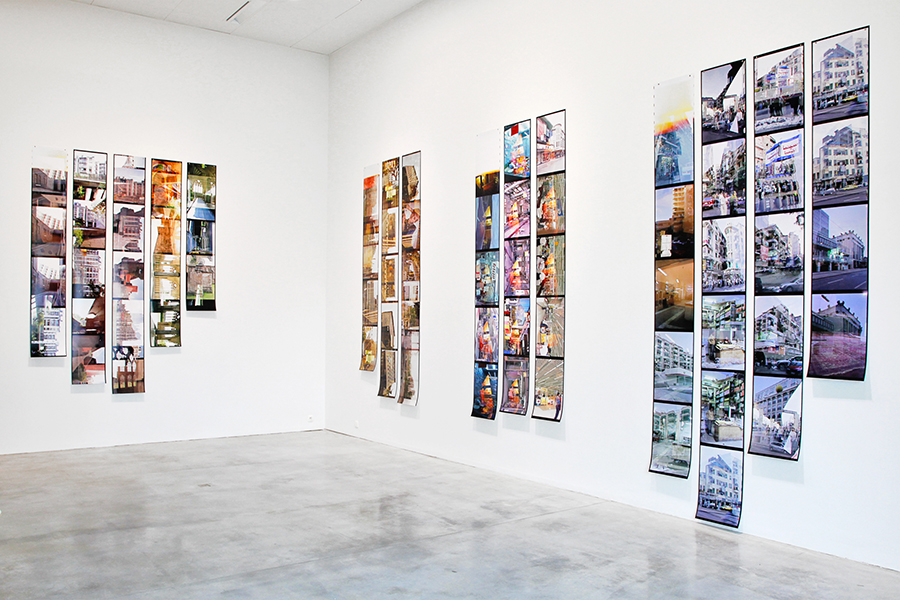
Aglaia Konrad
Zweimal belichtet, exhibition view
2.
The series “Zweimal belichtet” incorporates several rolls of film that were accidentally used twice. These mishaps were not programmed but the result of a specific working method that accompanies the analogue process. As Konrad photographs the same subjects in black and white and in colour, and hence constantly recharges her camera with different film rolls, a mix-up may occur in which she re-uses an already exposed film roll. Only after development she noticed the mistake: two shots taken at different moments and showing different subjects are mashed together in a layered and fractured image. The film rolls that unfurl before the viewer show a continuous flow of extremely hard to read images. As different spaces and times crash into one another, with their lines, colours and forms awkwardly fused, the world is no longer recognizable but becomes a hotchpotch of fragments. The double exposures are not superimposed in a discernable hierarchy, but coalesce into an intangible mess.
Confronted with this clutter, the viewer starts to loose his bearings: his eye is unable to rest on one of the double takes, zooming in and out like an auto-focus camera. Indeed, the viewing experience is tantamount to what occurs while the photographer looks through his viewfinder: both observer and photographer seem immersed in that moment when the image is out of focus, when everything that meets the eye is in the process of becoming. But, while the ordeal of the photographer usually ends successfully, the viewer is not so lucky here: he remains stuck in this moment where everything still wavers between presence and absence
Although these images originated as failures, they are consciously recuperated as intriguing examples of an intrinsic part of the (analogical) photographic process.
Their unreadability effectively overturns normative conceptions of the photographic image and its composition, but it also explores those unforeseen visual possibilities contained within the photographic medium. Indeed, these bewildering images are testimonial to the crucial role that chance plays in the photographic act. The photographic image, as a technological and chemical process, is the consequence of a camera that « looks » indiscriminately at the world, soaking in everything what is in front of it, making no distinction between what is important and what is not. It is in the slipstream of this automatic process that chance asserts its (potentially damaging) role. It is up to the photographer then to play with chance, to strike the right balance between control and surrender, and, in fact, to use chance as that « sting of the real » which invigorates the photograph. Yet Konrad’s double impressions seem to have arisen from a picture-taking system in which chance took over. As such, they remind us of the dangerous (and therefore titillating) novelty the photographic act introduced in the visual culture of the 19th century, when, with the advent of the camera, anything could be depicted-whenever, whatever, wherever: such was the image-making credo introduced by the camera. When contingency takes the overhand and chance dominates the production of the image, the coherence the photographer is supposed to bring to the image collapses. As a result, the photographic agent is superimposed by an « other, » and perhaps more radical, image-making process, one in which the techno-scientific laws of the photographic system rule.3.
Another photographic conundrum radiates from the series “Undecided Frames”. This work consists of pairs of photographs that are juxtaposed in a frame, with only a broad white border separating them. Although the photographs look similar at first, they display competing versions of one and the same image, the barely noticeable differences between them the results of a camera that has moved ever so slightly. One photographic pair, for example, shows a construction/destruction site in Chongqing, China. In the left image, the area is frontally photographed, with the camera pointed straight ahead, while the right captures the scene with the camera slightly tilted downward. In principal, nothing has changed: the lorry is still seen standing on the upper bridge and the man-potentially the driver-is still leaning on the rail. The photographs are shot within a relatively short timeframe, yet they present a different view: one photograph looks more balanced whereas the other shows the scene in a more dynamic way, as if stressing the dialectic between the construction of the highway and the destruction of the houses. Two very different takes, then, and yet, as the title intuits, no choice could be made? In sabotaging the moment of selection, Konrad’s Undecided Frames not only highlights the absurdity of the photographic act but also muddles the relationship between the four parties involved in photography: photographer, camera, world and viewer.
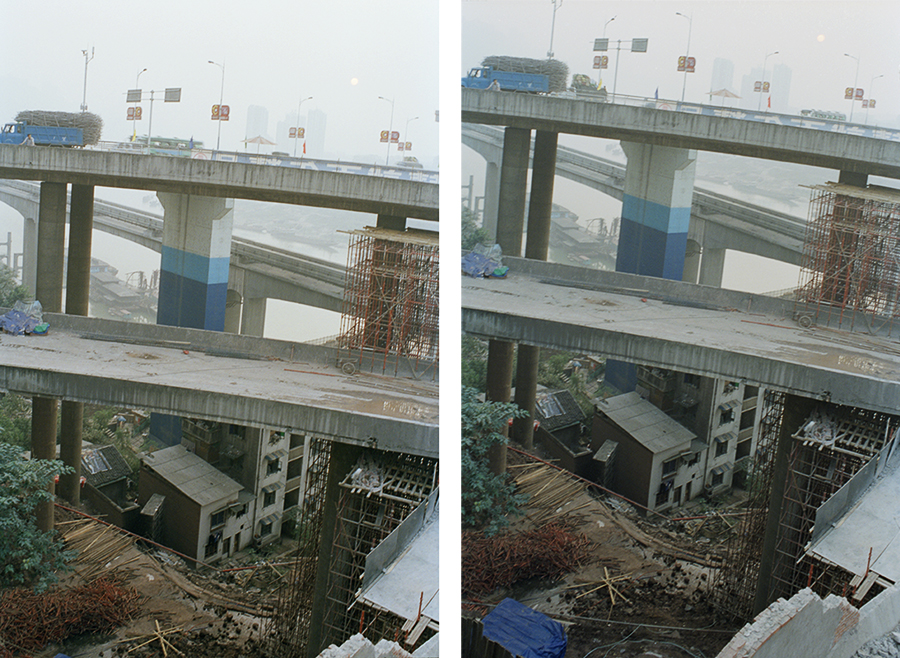
Aglaia Konrad
Undecided frames (Chongqing), 2012
colors photography, 41 x 54 cm. Ed 5/5
Suggested by the title, these pairs express an impossibility to choose « the right image. » As the camera makes no mistakes-each and every technical image is a viable alternative-there is no good or bad image logically speaking: photography simply measures and captures the light refracted by whatever falls within the scope of the lens. Put differently, to say that a photographic image fails is to introduce an act of judgement, performed by a discerning subject that declares the photograph good, bad, interesting, deficient, etc. Because the mechanical nature of the medium asserts that every image is nonetheless right and also because the criteria, standards, and convictions on which aesthetic judgement is based transfigure historically- a particular form of indecisiveness that is intimately linked to the photographic act as such comes to the fore. While the photographer and the camera start as an inseparable unity, the moment the photographer presses the button this unity is violently severed, both following for a brief moment of time their own path, their own logic.
Only later on, when the image is developed and the photographer meets the result on the contact sheet, will he find himself included again in the photographic process, though now engaged in a discussion about which image to accept or reject. The photographic act installs an undecidability following directly from the action of the camera, but also, indirectly, from the discrepancy between that logic and the (mutable) set of aesthetic standards the photographer adheres to.
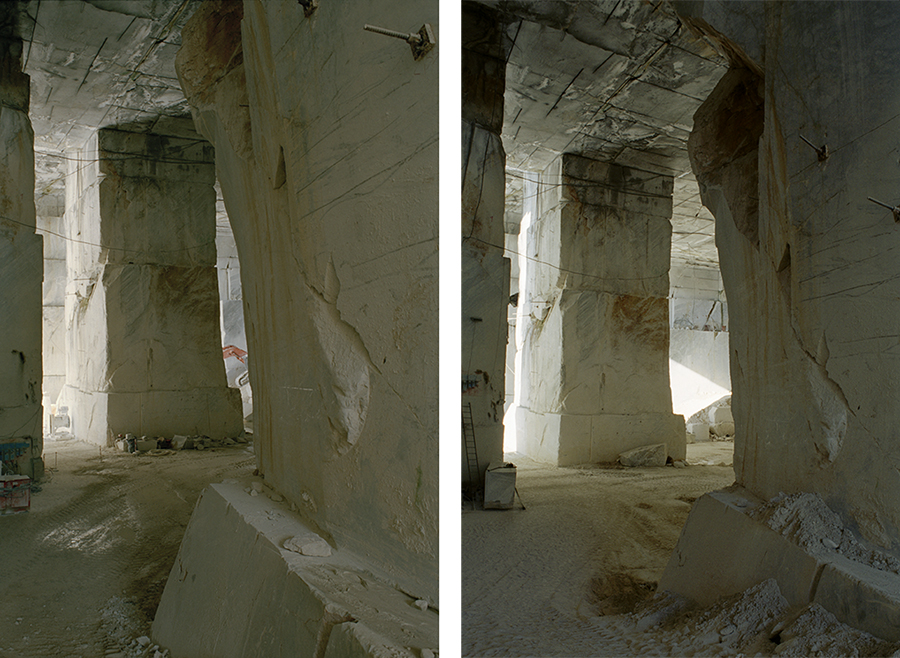
Aglaia Konrad
Undecided frames (Carrara), 2012
colors photography, 41 x 54 cm. Ed 5/5
Two photographs of a rectangular column of marble in the Carrara quarries illustrate another of these inherently photographic paradoxes. Reading them left to right, these images infer a slight movement backwards and to the left. But we don’t really see such a movement, we only notice a jump between two different spatial positions (with the white, in-between border acting as « dead time »). Like other pairs in the series, this photographic couple differentiates our own, phenomenological sense of being in the world from the camera’s: where we experience a spatiotemporal continuum and glide fluently from one moment/place to another, the apparatus stutters and carves up the spatiotemporal continuum into discrete, discontinuous moments/places. On another level, the differences between the double takes could also be understood as a reference to Konrad’s working method. They would express her careful exploration of the subject, a continuous probing of it with the camera, the slight changes expressing a vivid but also somewhat fuzzy negotiation with the world. However, by each time limiting herself, in a body of work titled “Undecided Frames”, to only two images, she also points out that these photographs shouldn’t be seen as alternatives for one another, but as separate images in their own right. Immediately the problem of choosing reasserts itself, albeit with a slightly different and somewhat unexpected outcome: choosing becomes impossible not because these two images look similar, but because they are incomparably different.
In refusing to choose, Konrad also reclaims her position as an intermediary between image and viewer. Bringing the differences between the two images (however small they might be) to the notice of the viewer, she makes clear that every photographic image is the result of her subjective choices. Moreover, by naming these double takes « undecided » she manoeuvres the viewer into a situation he normally never has to deal with, the moment of choosing being a solitary moment, safely hidden from the prying eyes of the public. Now the question of choosing becomes our problem: are we supposed to make the choice Konrad didn’t want to make? Maybe, but for us, this idea of choosing is even more senseless than it was for her, because we have no stake in this choice. The only option we are left with is to nod our head from left to right (and back again), searching in vain for a way out of this either/both/neither dilemma. We find ourselves forever stuck in the impossible logic of the photographic system.
4.
It is no surprise that “Zweimal belichtet” and “Undecided Frames” are intrinsically linked to the contact sheet: there Konrad encountered the technical failure and the visual promise of the double exposures, and there she experienced, given the logic of the camera, the fundamental arbitrariness of each choice. The contact sheet is the source from which every project starts, a reservoir of images that serves as an onset to explore the astonishing flexibility of the photographic image, and the medium of photography, in exhibitions, book projects, and installations. As images are not bound to any specific support and have no fixed dimensions or order-always on the move and never settling down- Konrad brazenly experiments with the material form and production method of the photographic image. One feature, however, stands out: she rarely crops or cuts into her images. Her interventions deal with the more tangible aspects of the photographic image – like its support, its dimensions, etc.- not with the more careful and balanced manipulations of light and dark in the darkroom. Konrad is not a photographer of the chemical layer, of the photographic post-production, but one of the optical system, of the lens, of the choices made during aiming and framing. Something of this reverence for the full image is visible in “Zweimal belichtet” and “Undecided Frames” as well. In the former, Konrad accepted the film rolls as such: no cuts were made and no parts were given preference to, since the film rolls are presented as a continuous whole. In the latter, the problem of choosing can only be taken serious, as the images haven’t been tampered with: her « indecisiveness » is not a mere subjective, constructed dilemma, but a problem integral to photography itself.
Steven Humblet teaches theory and history of photography at LUCA School of Arts, Brussels. He has studied philosophy and anthropology, wrote a dissertation on Benerice Abbott’s “Changing New York”, and publishes regularly on photography.
[sociallinkz]